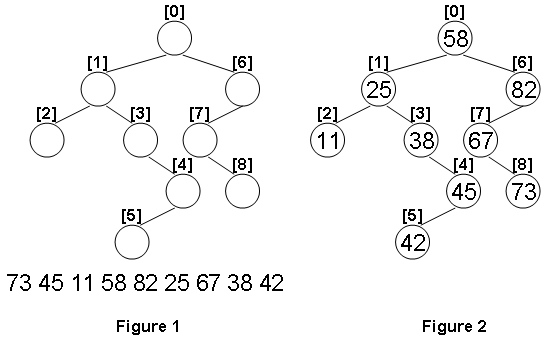PAT Advanced 1099 Build A Binary Search Tree (30分)
Posted littlepage
tags:
篇首语:本文由小常识网(cha138.com)小编为大家整理,主要介绍了PAT Advanced 1099 Build A Binary Search Tree (30分)相关的知识,希望对你有一定的参考价值。
A Binary Search Tree (BST) is recursively defined as a binary tree which has the following properties:
- The left subtree of a node contains only nodes with keys less than the node‘s key.
- The right subtree of a node contains only nodes with keys greater than or equal to the node‘s key.
- Both the left and right subtrees must also be binary search trees.
Given the structure of a binary tree and a sequence of distinct integer keys, there is only one way to fill these keys into the tree so that the resulting tree satisfies the definition of a BST. You are supposed to output the level order traversal sequence of that tree. The sample is illustrated by Figure 1 and 2.

Input Specification:
Each input file contains one test case. For each case, the first line gives a positive integer N (≤) which is the total number of nodes in the tree. The next N lines each contains the left and the right children of a node in the format left_index right_index, provided that the nodes are numbered from 0 to N−1, and 0 is always the root. If one child is missing, then − will represent the NULL child pointer. Finally N distinct integer keys are given in the last line.
Output Specification:
For each test case, print in one line the level order traversal sequence of that tree. All the numbers must be separated by a space, with no extra space at the end of the line.
Sample Input:
9
1 6
2 3
-1 -1
-1 4
5 -1
-1 -1
7 -1
-1 8
-1 -1
73 45 11 58 82 25 67 38 42
Sample Output:
58 25 82 11 38 67 45 73 42
这题考察了给定左子树,右子树,然后再给出数字,按照给定进行构建树,最后输出层序遍历。
我们先对其进行排序,就是中序的结果。
我们仅需要在构建的时候,进行加一个level进行代表层级,用一个index代表索引,然后利用level和index进行排序即可。
最后按次序输出就是所得结果
#include <iostream> #include <vector> #include <algorithm> using namespace std; struct node { int index, val, left, right, level; }; bool cmp(node& n1, node& n2){ return n1.level == n2.level ? n1.index < n2.index: n1.level < n2.level; } int N; vector<node> v; vector<int> data;int k = 0; void inorder(int root, int index, int level){ if(v[root].left != -1) inorder(v[root].left, 2 * index + 1, level + 1); v[root] = {index, data[k++], v[root].left, v[root].right, level}; if(v[root].right != -1) inorder(v[root].right, 2 * index + 2, level + 1); } int main(){ cin >> N; v.resize(N); data.resize(N); for(int i = 0; i < N; i++) cin >> v[i].left >> v[i].right; for(int i = 0; i < N; i++) cin >> data[i]; sort(data.begin(), data.end()); inorder(0, 0, 0); sort(v.begin(), v.end(), cmp); cout << v[0].val; for(int i = 1; i < N; i++) cout << " " << v[i].val; system("pause"); return 0; }
以上是关于PAT Advanced 1099 Build A Binary Search Tree (30分)的主要内容,如果未能解决你的问题,请参考以下文章